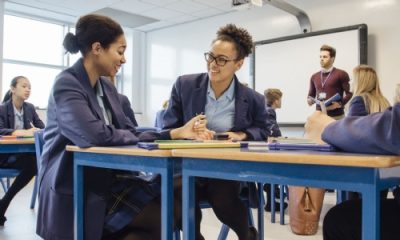Improving children’s concentration and keeping them focussed in the classroom can be a mammoth task at times! especially when dealing with older children as they go through puberty or excitable primary school pupils. Lack of concentration is not just a problem for school pupils. Numerous studies found that British adults have an average attention span of less than 20 minutes. There is a lack of focus growing amongst all generations, because of technology and a faster pace of life. So, it is no wonder that children increasingly struggle to concentrate in class.
A lack of concentration in adults may result in missing part of a good television programme. Whilst poor concentration in children can affect their education negatively. There is a plethora of reasons that a child may be struggling with concentration in class. Some may be out of their control; such as children with learning difficulties. Impacted either by distractions by their environment, or not being taught in their preferred learning style. Unfortunately, no matter what the reasons are for low concentration, a lack of engagement and focus can lead to poor performance and grades. Plus, a dislike of school and perpetuate disruptive behaviour.
Whilst you cannot fully eradicate classroom distractions our tips below may help increase concentration.
1. Diet and water
Some methods for improving a child’s focus need to start before they even enter that classroom. A child’s diet is hugely important to their levels of concentration. Food works to nourish the brain as well as the body.
Breakfast is the most important meal of the day for everyone. Feeding children the correct foods in the morning can be the trick to keeping them engaged for longer. Foods such as oat cereals, porridge and bananas release their energy slowly. They will keep children going for longer, as well as feeding their brains consistently throughout the morning.
Conversely, less healthy options such as sugary cereals give children a burst of energy that fades quickly. This means that children’s brains will burn out quicker. They will feel hungry well before their lunch break – and there is no bigger destroyer of focus than hunger! Another disadvantage to foods high in sugar is that it can give some children ‘too much’ energy with no place to release it. This results in distracting behaviour to classmates and teachers.
Interestingly, Omega Fish Oils are a beneficial supplement for boosting concentration. This is especially important during exam periods. The Durham Trial, conducted by Dr Alex Richardson and Madeleine Portwood giving children Omega 3 supplements to improve performance found that 40% of participants showed some clear improvement.
Lastly, fresh and natural foods are greatly beneficial for children. A study by the University of Ulster showed that greens and fruits inject the body with antioxidants that boost brain power. Diet affects memory, focus and mental capacity, as well as concentration. It is crucial that attention is given to it. Children’s brains are developing rapidly and require the correct nutrition.
It is also what children drink and how much that affects their concentration levels. Several studies prove that drinking water throughout the day is best. There is a trend for children drinking caffeine and sugary, energy drinks at much younger age than they previously have. However, these drinks provide children with sugar overloads and provide little to no nutritional value at all.
2. Exercise
Exercise is incredibly beneficial for improving children’s concentration. Walking to school, rather than driving or taking public transport, improved student concentration levels throughout the morning. (A study carried out by Danish Science Week)
As well as the psychological benefits of walking to school, this form of exercise is great for children’s general wellbeing. The study found that time spent outdoors promoted positive mental health. 98% of teachers stated that time outside improved children’s social skills and 84% said that it made children happier.
In terms of student concentration levels, teachers also saw impressive results; 75% stated that outdoor play improved concentration. Providing children with space and time to run around and play uses up physical energy before class begins. So they are ready to sit and focus.
3. Sleep and relaxation
A good sleep routine will help children function better throughout the day. It gives their mind and body the optimal time it needs to replenish itself from a long day at school (full of interaction, focus and play). Children between the ages of 6 and 13 require 9-11 hours of sleep a night for several reasons. Firstly, children need sleep to develop naturally and happily. Secondly, poor sleep patterns can result in irritable and moody behaviour. Lastly, children are increasingly exposed to screen and technology, so breaks are required from these devices.
Periods of relaxation are another aspect of children’s routine that can facilitate better concentration later on. It is important to note that ‘relaxation’ is different from play or free time. It is not advisable for children to play on game consoles during ‘relaxation’ time, as it requires a different type of concentration. Many teachers and parents have taken to mindfulness exercises throughout the school day. They calm students down and refocuses their minds, improving children’s concentration.
4. Organisation
Whilst organisation could appear to be a superficial way to get children to concentrate more it helps declutter and distract students’ minds from the task ahead. These are two areas that organisation can be assessed;
- the student’s ability to organise themselves; and
- the environment e.g. classroom set up.
If students make a concerted effort to keep organised. Such as notes with colour coded tabs or separate subject folders, it can eliminate the time spent hurriedly searching for pieces of work or notes when they require them. This also allows children to take control of part of their learning process by finding an organisational method that best suits their way of working and information processing. As well as this, paying attention to note organisation can better alert children to missing work or incomplete notes. This can be a reason for lower performance. It is not only their work that they can better organise, but cleaning their private spaces such as desks with storage, lockers and backpacks can also help declutter student’s minds and focus on class. Clear spaces will make it easier for children to find their belongings and decrease time lost to searching.
Lastly, the classroom itself can sometimes be a cause for distraction and daydreaming, particularly in primary schools. Naturally, when teaching younger children, teachers want to expose them to the exciting aspects of learning such as colour and imagery. However, heavily decorated classroom walls can also serve as a huge distraction for children by almost becoming a “sensory overload”. Not all decoration is bad and can be beneficial, particularly if it helps inform children. However, careful consideration and moderation of classroom decoration can help with improving children’s concentration.
5. Seating plan
One of the biggest distractions in the classroom are the children themselves. When they aren’t talking to their neighbour, passing notes, or balancing on chairs, some children are being distracted by gadgets. An Ofsted report showed that 11% of teachers described ‘using mobile devices’ as a cause for lack of concentration in the classroom. However, whilst some dynamics could become a nuisance in the classroom, they can be managed in a way that makes them beneficial for students and teachers alike. A carefully considered seating plan is the best way to constructively deal with these interactions.
When making a seating plan there are a few aspects to consider; girl-boy-girl-boy formats, avoiding creating a ‘naughty table’ and children who require more support. Firstly, although there are benefits to create seating plans by alternating students of the opposite sex it can disadvantage some students more than others. For example, if you sit a boy between two more confident and able girls, he could become introverted. This can be an issue in secondary schools where girls, generally speaking, become more vocal. A student’s concentration will not be affected positively if they feel that they cannot be heard or experience a confidence blow. Instead, they may give up and turn their focus elsewhere.
Some children want to concentrate on their work but just need more attention and support than others to do so. If you become aware of a child who would benefit from more attention, the best thing to do is to seat them at the front of the class. That way, they have easy access to the teacher and cannot be further distracted by what is behind them.
These tips are a great starting point for improving children’s concentration. Hopefully they will help you keep students focussed in the classroom.


